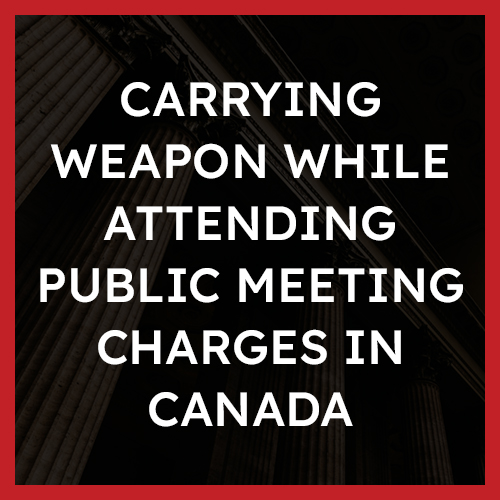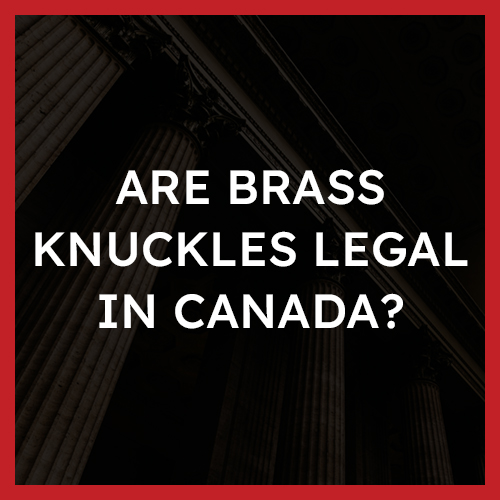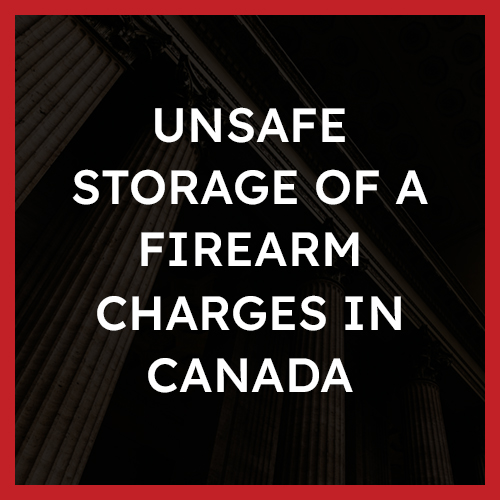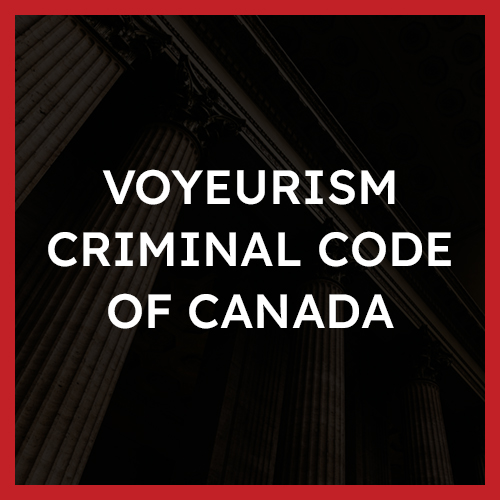Carrying Weapon While Attending Public Meeting Laws in Canada Explained
What is a Carrying Weapon While Attending Public Meeting Charge?

A carrying weapon while attending public meeting charge occurs where an individual carries a weapon, prohibited device or ammunition while the individual is on the way or attending a public meeting, without lawful excuse to do so. Weapons are defined under s. 2 of the Criminal Code (1988): a weapon is anything that is used or intended to be used to cause injury, death, for the purpose of threatening or intimidating another as well as any firearms defined under s. 82 of the Criminal Code (1988).
Carrying weapon while attending public meeting is a summary offence. Summary offences are governed under Part XXVII of the Criminal Code, under the “Summary Conviction” section. Summary convictions have maximum penalties of two years less a day in jail, a $5000 fine, or both.
Examples
Some examples of a carrying weapon while attending public meeting may include the following:
- The accused carried a concealed weapon on public transportation;
- The accused attended a protest with a weapon;
- The accused carried a weapon, such as a prohibited knife, while in a restaurant; and
- The accused attended a public event, with ammunition and no lawful excuse to do so.
Defences
The defences available to a carrying weapon while attending public meeting charge depend entirely on the facts of your case.
However, some defences to a carrying weapon while attending public meeting charge may include:
- The accused had a lawful excuse to carry a weapon while attending a public meeting;
- The accused was not carrying a prohibited weapon while attending a public meeting;
- The accused was carrying a knife, which does not qualify as a weapon, and did not have the intention to use it as a weapon;
- The accused was wrongfully identified as the person who carried a weapon while attending a public meeting; and
- The accused was not arrested lawfully.
Punishment
A carrying weapon while attending public meeting charge is a summary offence, which means the maximum punishment is as follows:
- Imprisonment for a term of up to but not including 2 years and a $5000 fine.
Punishments for carrying weapon while attending public meeting depend on if the Crown elects to pursue the charge as an indictable offence or summarily. There are no mandatory minimum penalties for this offence. The maximum is two years less a day, and a potential fine of $5000.
A carrying weapon while attending public meeting charge results in a criminal record, and may entail severe consequences for current and future employment opportunities and immigration status.
Overview of the Offence
According to s. 89 of the Criminal Code:
Carrying weapon while attending public meeting
89 (1) Every person commits an offence who, without lawful excuse, carries a weapon, a prohibited device or any ammunition or prohibited ammunition while the person is attending or is on the way to attend a public meeting.
Punishment
(2) Every person who commits an offence under subsection (1) is guilty of an offence punishable on summary conviction.
The Guilty Act (Actus Reus)
The actus reus for a carrying weapon while attending public meeting charge under s. 89 is established by proof, beyond a reasonable doubt, of the following:
Carrying Weapon While Attending Public Meeting 89(1)
- The accused at a specified date and time, carried a weapon, prohibited device, or ammunition as defined under s. 89;
- The accused was on their way to a public meeting; and
- The accused had no lawful excuse for committing the act.
OR
- The accused at a specified date and time, carried a weapon, prohibited device, or ammunition;
- The accused was attending a public meeting; and
- The accused had no lawful excuse for committing the act.
The actus reus refers to the act or the omission itself that constitutes the physical elements of a crime. Thus, the physical aspect of carrying a weapon while attending public meeting would be constituted by any physical act or omission as defined in s. 89. One example of actus reus would be carrying a prohibited knife into a public protest.
The Guilty Mind (Mens Rea)
The mens rea for a carrying weapon while attending public meeting charge under s. 89 includes proving, beyond a reasonable doubt, that:
- The accused knowingly carried a weapon, device or ammunition, whether prohibited or not, while going to a public meeting; and
- The accused had no lawful excuse for doing so.
OR
- The accused knowingly carried a weapon, device or ammunition, whether prohibited or not, while attending a public meeting; and
- The accused had no lawful excuse for doing so.
Mens rea is defined as the knowledge or intention of committing the crime. Thus, knowing that one is carrying a firearm while attending a public event and having no lawful excuse to do so, consists of the mens rea of the charge. As noted in R v Felawka, the Crown must prove that beyond a reasonable doubt, that the accused knew he was carrying an object that he also knew was a weapon.
Defences
How to Beat a Carrying Weapon While Attending Public Meeting Charge
Possible defences will depend on the facts and circumstances of your case. These, as well as the evidence available, will dictate the strength of each available defence. Listed below are some common defences that may be helpful in fighting a carrying weapon while attending public meeting charge.
Factual Innocence
Factual innocence is one possible defence against a carrying weapon while attending public meeting charge. If you can prove, using the facts and the evidence of your case, that you were not engaged in an act of carrying a weapon while attending or on your way to attend a public meeting, or, that the evidence cannot place you as the perpetrator of such an act, then you may be able to defend yourself by stating that you were factually innocent. This can be done for example by proving, beyond a reasonable doubt, that you were not on your way to a public meeting while carrying a weapon.
Lawful Excuse for Carrying a Weapon While Attending a Public Meeting
For this to be a defence against a carrying weapon while attending public meeting charge, you must be able to show that you were legally allowed to carry a weapon while attending a public meeting. To do so, you would have to show proof of your legal capacity to carry a weapon in a public meeting.
Identity
A defence based on the identity of the perpetrator may be a defence to a carrying weapon while attending public meeting charge. For this defence to be raised successfully in court, you would have to prove that you did not commit this act. Alternatively, if you can prove that you were not there at the time the offence was committed, you would raise an alibi defence. This is a defence that states that the accused was wrongfully convicted. Evidence that can be submitted to create a solid identification defence is eyewitness identification, DNA evidence, media, and fingerprints.
Any Applicable Charter Defences
The Charter sets out your rights and freedoms before and after your arrest. If the police fail to abide by these rights deliberately or inadvertently, it could aid in your defence. If any of your Charter rights have been violated before or after your arrest, you may be able to have some or all of the evidence that the Crown is relying on to secure a conviction excluded under s. 24(2) of the Charter.
Punishments
The Criminal Code provides for a possible term of imprisonment of two years less a day imprisonment. A fine is also possible under this section, either in conjunction with imprisonment or alone. Individuals who are charged with this act may also have their weapons seized by law enforcement.
Those found guilty of carrying a weapon while attending a public meeting, are also eligible for a release by peace officer on undertaking through s. 498, 499 and 501 of the Criminal Code, for an appearance notice by peace officer under s. 497, and/or for a summon by judge or justice, under s. 508(1), 512(1) or 788 of the Criminal Code. Therefore, when charged, the individual may be given an appearance notice without arrest or summons, and when arrested, the individual may be released by the arresting officer on an undertaking.
The accused will not be required to attend a police station to have their fingerprints taken under the Identification of Criminals Act.
Frequently Asked Questions
What is the punishment for misconduct by officers executing process?
If you are found guilty of a misconduct by officers executing process charge, your punishment will vary depending on whether the Crown proceeds summarily or by indictment. If the Crown proceeds by indictment, a misconduct by officers executing process charge carries a maximum sentence of no more than two years in jail. If the Crown proceeds summarily, the maximum punishment is no more than 6 months of incarceration and/or a $5,000 fine. No minimum punishment is outlined.
Can you go to jail for misconduct by officers executing process?
If you are found guilty of misconduct by officers executing process, you can go to jail. If the Crown proceeds by indictment, a misconduct by officers executing process charge carries a maximum sentence of no more than two years in jail. If prosecuted summarily, the maximum punishment is no more than 6 months of incarceration. There is no minimum jail sentence whether the Crown proceeds summarily or by indictment. Therefore, there is a possibility that you can go to jail for a misconduct by officers executing process charge, but it is not guaranteed.
What type of offence is misconduct by officers executing process?
Misconduct by officers executing process is a hybrid offence. This means that the Crown may decide to proceed summarily, or by indictment. If the Crown proceeds by indictment, a misconduct by officers executing process charge carries a maximum sentence of no more than two years in jail. If the Crown proceeds summarily, the maximum punishment is no more than 6 months of incarceration and/or a $5,000 fine.
Published Decisions
R v Felawka, 1993 CanLII 36 (SCC)
After target shooting with a friend, the accused took public transit back home. He had wrapped his firearm, which had a clip with one live round, in his jacket, as he thought it would not be proper to openly carry the firearm. This caused some suspicion in a couple of passengers, who alerted the train employee. The accused communicated briefly with the employee, then left the train, and boarded a bus, where he was arrested. At trial, he was convicted of having breached section 89, and acquitted of section 87, which is carrying a weapon for a purpose dangerous to the public peace. The Supreme Court of Canada examined the definition of weapon and firearm as well as the mens rea required for the offence.
The court concluded that firearms were weapons under s. 89, regardless of intent, and that secondly, the mens rea of the offence is proven, beyond a reasonable doubt, when the Crown can show that the accused concealed an object that he knew to be a weapon. The court thus held that carrying a firearm in a case would not contravene s. 89 as it shows that there is a firearm within, whereas the way the accused had kept it in his jacket would be considered an attempt to hide the rifle itself.
You can read the full decision here.
R v S. (C.), 2003 SKPC 40
The accused, a student, was clicking a small hunting knife open and shut in one of his classes. He produced the knife when the teacher asked him to do so. When he did so, he was escorted to the vice-president’s office, where he was subsequently charged.
The court concluded that he was not deliberately trying to harm or intimidate anyone. The judge notes that the knife was not designed to be a weapon as defined within the Criminal Code. Looking at whether the accused intended to use the knife as a weapon, the judge concluded that he had reasonable doubt that the knife was to be used as a weapon. In order to prove the mens rea of the s. 89 offence, the evidence must demonstrate beyond a reasonable doubt, that the accused concealed an object he knew to be a weapon.
The judge therefore dismissed the case, finding that the accused merely had a knife in his pocket. This is not enough to charge him under s. 89.
You can read the full decision here.
R v Sasakamoose, 1989 CanLII 4533 (SKPC)
The accused was arrested for intoxication, after a member of the public complained to a police officer. The accused produced a sharpened knife wrapped in newspaper when questioned. Under section 2 of the Criminal Code, the court found that the knife could not, with reasonable doubt, be found to be a weapon. The court referred to R v Blondell, a 1972 case, where the accused was found with a butcher knife in his pants while in a beer parlour. The court found that the knife was not designed to be a weapon, but that the accused could have intended to use it as a weapon if the occasion arose and thus convicted the accused. In R v Sasakamoose, however, the court found that the requisite intent was not there, and the accused was found not guilty.
You can read the full decision here.
Contact Us
If you have been charged with a criminal offence, visit our location pages to contact our team.
About The Author
Ask A Question
We endeavor to respond to questions within 24 hours. If your matter is urgent, please call our office or submit a request for a free consultation.







